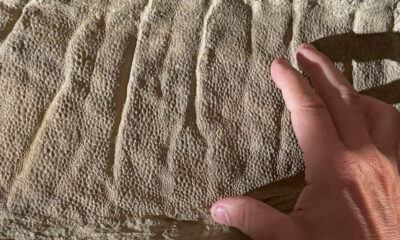Science
New Discoveries of Edmontosaurus Mummies Transform Dinosaur Image

A recent excavation in east-central Wyoming has led to the discovery of two additional mummies of the duck-billed dinosaur, Edmontosaurus annectens, providing unprecedented insights into its physical characteristics. This groundbreaking research, led by Paul C. Sereno, a professor of organismal biology at the University of Chicago, builds on the initial findings by fossil collector C.H. Sternberg in 1908. The mummies, preserved in a remarkably thin layer of clay, reveal new details about the dinosaur’s skin texture, scale size, and anatomical features.
The initial Edmontosaurus skeleton, known as the “AMNH mummy,” was housed at the American Museum of Natural History in New York and served as the basis for early artistic representations. However, over time, various interpretations emerged, leading to conflicting images of the dinosaur. The new discoveries aim to clarify these misunderstandings and provide a more accurate representation of Edmontosaurus.
Revisiting the Past
Since Sternberg’s time, the understanding of Edmontosaurus has evolved. The first reconstruction, created by paleoartist Charles R. Knight in 1909, inaccurately depicted the dinosaur with a crest extending along its entire body. Subsequent studies, including one by renowned paleontologist Jack Horner in 1984, introduced new elements but still lacked precision. The recent findings by Sereno’s team aim to consolidate these interpretations into a definitive image of the dinosaur.
Sereno’s team retraced Sternberg’s steps to locate the original dig site, relying on historical notes and local knowledge. Their efforts led them to a fertile area, less than 10 kilometers in diameter, rich in fossils known as the “mummy zone.” This region is part of the Lance Formation, which dates back to the last three million years of the Cretaceous period.
Geological Insights
The Lance Formation, extending across multiple states including Wyoming and Montana, is characterized by unique sedimentary conditions. According to Sereno, the thickness of the formation increases dramatically in the mummy zone, suggesting an exceptionally high sedimentation rate likely due to frequent flooding. This phenomenon resulted in the rapid burial of dinosaurs, preserving their remains under layers of mud and clay.
Sereno describes this preservation method as “clay templating,” a process that creates a thin mask of the dinosaur’s skin. This technique has been recognized in studies of deep-sea organisms but had not been previously documented in large dinosaurs. The team retrieved two additional Edmontosaurus mummies, with clay masks less than one millimeter thick, that provided life-like details of the animal’s appearance.
The analysis of these mummies utilized modern imaging techniques, including CT scans and photogrammetry, allowing for a comprehensive reconstruction of the dinosaur’s external features. This updated model revealed a significant departure from previous representations, including the presence of hooves on its legs.
New Discoveries and Their Implications
Among the most striking findings is the revelation that Edmontosaurus possessed small scales, measuring between one and four millimeters, much smaller than previously thought. The skin, covered in these tiny scales, was also found to be remarkably thin. In a surprising twist, the dinosaur featured hooves similar to those of modern equines, challenging previous assumptions about the evolution of such structures.
Sereno’s research suggests that Edmontosaurus was not only a significant discovery in terms of its size but also represented a transitional form in the evolution of hooved animals. The mummies provided evidence of the earliest hooves in land vertebrates, marking a pivotal point in the evolutionary history of dinosaurs.
While the Edmontosaurus mummies have drawn considerable attention, other notable finds in the mummy zone include remains of a T. rex and a Triceratops. Sereno indicated that the T. rex was preserved in a life-like pose, possibly indicating it was buried alive, while the Triceratops exhibited significantly larger scales and thicker skin. These discoveries may provide further insights into the physiological differences between these species, despite their similar size and habitat.
As Sereno remarked, “We are in the age of discovery. There are so many things to come.” The ongoing research promises to continue unveiling the mysteries of these ancient creatures and refine our understanding of their biology and ecology. The upcoming studies focusing on the Triceratops and T. rex will likely expand the scope of knowledge regarding Cretaceous dinosaurs and their environments, paving the way for future discoveries in paleontology.
Science, 2025. DOI: 10.1126/science.adw3536
-

 Politics1 week ago
Politics1 week agoSecwepemc First Nation Seeks Aboriginal Title Over Kamloops Area
-

 World4 months ago
World4 months agoScientists Unearth Ancient Antarctic Ice to Unlock Climate Secrets
-

 Entertainment4 months ago
Entertainment4 months agoTrump and McCormick to Announce $70 Billion Energy Investments
-

 Lifestyle4 months ago
Lifestyle4 months agoTransLink Launches Food Truck Program to Boost Revenue in Vancouver
-

 Science4 months ago
Science4 months agoFour Astronauts Return to Earth After International Space Station Mission
-

 Technology3 months ago
Technology3 months agoApple Notes Enhances Functionality with Markdown Support in macOS 26
-

 Top Stories1 month ago
Top Stories1 month agoUrgent Update: Fatal Crash on Highway 99 Claims Life of Pitt Meadows Man
-

 Sports4 months ago
Sports4 months agoSearch Underway for Missing Hunter Amid Hokkaido Bear Emergency
-

 Politics3 months ago
Politics3 months agoUkrainian Tennis Star Elina Svitolina Faces Death Threats Online
-

 Politics4 months ago
Politics4 months agoCarney Engages First Nations Leaders at Development Law Summit
-

 Technology4 months ago
Technology4 months agoFrosthaven Launches Early Access on July 31, 2025
-

 Top Stories3 weeks ago
Top Stories3 weeks agoFamily Remembers Beverley Rowbotham 25 Years After Murder




















